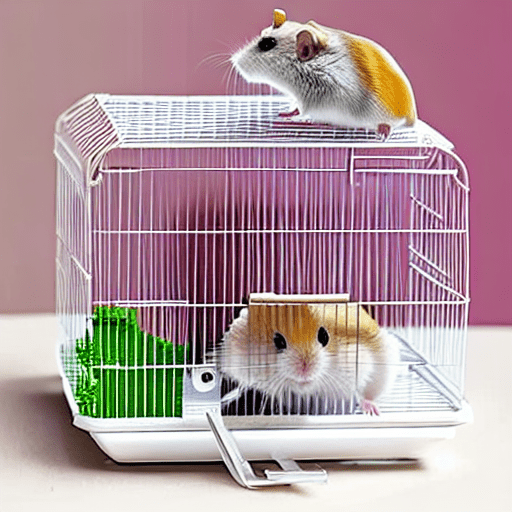How Often Do You Change Hamster Bedding? Discover the Essential Maintenance Routine!
Importance Of Regularly Changing Hamster Bedding
Importance of Regularly Changing Hamster Bedding Regularly changing your hamster’s bedding is essential for their overall health and well-being. It helps prevent odor and bacteria buildup, creating a clean and hygienic environment for your furry friend. Fresh bedding plays a crucial role in maintaining your hamster’s health. Proper ventilation and cleanliness prevent respiratory issues, such as allergies or infections, which can be caused by the accumulation of dust, mold, and urine in bedding. Additionally, regularly changing the bedding helps to keep your hamster’s cage free from parasites, such as mites and fleas, which can flourish in dirty bedding. Frequent bedding changes also promote mental stimulation for your hamster. Clean bedding creates a fresh and inviting space for them to explore and engage in natural behaviors, such as burrowing or nesting.| Health Benefits | Explanation |
|---|---|
| Preventing odor and bacteria buildup | Fresh bedding helps maintain a clean and hygienic environment, preventing unpleasant odors and harmful bacteria. |
| Respiratory health | Regular bedding changes reduce the risk of respiratory issues caused by dust and mold accumulation. |
| Preventing parasites | Clean bedding minimizes the presence of mites and fleas, ensuring your hamster stays free from infestations. |
| Mental stimulation | A fresh and clean environment encourages natural behaviors and provides mental enrichment for your hamster. |
Factors Affecting Bedding Change Frequency
One of the key factors that determine how often you should change the bedding for your hamster is the type of bedding material you are using. Some bedding materials may have better odor control and absorbency than others, which can affect how frequently you need to change it. Size of the enclosure is another important consideration, as a larger enclosure may require less frequent bedding changes compared to a smaller one. Additionally, the number of hamsters living together can impact the bedding change frequency. More hamsters in the same enclosure may lead to faster bedding saturation and odor build-up, necessitating more frequent changes. It is essential to monitor the condition and smell of the bedding regularly to ensure the health and comfort of your hamster. Remember to always provide fresh, clean bedding to create a hygienic environment for your furry friend.Signs It’s Time To Change The Hamster Bedding
Hamster bedding should be changed regularly to ensure the health and comfort of your furry friend. There are several signs that indicate when it’s time to change the bedding:- Noticeable odor: If you start to detect a strong smell coming from the cage, it’s a clear indication that the bedding needs to be refreshed. The accumulation of urine and feces can create an unpleasant odor that can be harmful to your hamster’s respiratory system.
- Appearance of mold or mildew: Inspect the bedding regularly for any signs of mold or mildew. These fungi can grow in damp conditions and pose a risk to your pet’s health. If you notice any discoloration or abnormal growth, it’s time to replace the bedding.
- Excessive dampness: Hamsters produce a significant amount of moisture, especially in warm or humid environments. If the bedding feels excessively damp to the touch, it may not be absorbing the moisture adequately. Damp bedding can lead to bacterial growth and discomfort for your hamster.
Recommended Frequency For Changing Hamster Bedding
When it comes to maintaining a clean and healthy environment for your pet hamster, it’s important to understand the recommended frequency for changing their bedding. Daily spot cleaning is an essential part of hamster care. This involves removing any soiled bedding or droppings that you come across during your daily interactions with your hamster. Not only does this help to prevent odors and bacteria buildup, but it also ensures that your hamster has a clean living space. In addition to daily spot cleaning, a complete bedding change is necessary every 1-2 weeks. This involves removing all the bedding material and replacing it with fresh, clean bedding. This not only helps to maintain hygiene but also provides your hamster with a comfortable and cozy nesting area. By following these guidelines, you can ensure that your hamster’s bedding remains clean and suitable for their needs.Tips For Proper Bedding Change
When changing your hamster’s bedding, it is important to use suitable gloves and tools. This will protect your hands from any potential irritants or allergens. Additionally, it is crucial to dispose of the old bedding properly. You can put it in a sealed bag before throwing it away to prevent any unpleasant odors from spreading. You should also ensure that the new bedding you use is safe for hamsters. Avoid using dusty or fragrant materials as these can irritate the hamster’s respiratory system. Instead, choose bedding made from natural materials such as paper or aspen shavings. These options are safe and comfortable for your furry friend. In summary, proper bedding change involves using suitable gloves and tools, disposing of the old bedding correctly, and ensuring the new bedding is safe for your hamster’s health and well-being.Maintaining Hamster’s Mental Stimulation During Bedding Change
Changing hamster bedding is an essential part of maintaining their health and well-being. However, it can be a stressful experience for your furry friend. To minimize stress during the process, it’s important to provide hiding spots and toys for your hamster to help maintain their mental stimulation. Hiding spots are crucial for your hamster to feel secure during the bedding change. Adding a small, enclosed house or a cardboard tunnel to their cage will create a safe space for them to retreat to. This will prevent them from feeling exposed and stressed. In addition to hiding spots, providing toys can also help keep your hamster mentally stimulated. Toys such as chew toys, puzzle toys, and exercise wheels will keep them entertained and engaged, diverting their attention from the bedding change and reducing stress. Remember, when changing the bedding, do it gradually and not all at once. Replacing a small portion of the bedding at a time will help your hamster adjust to the change more easily.Common Mistakes To Avoid When Changing Hamster Bedding
When changing hamster bedding, there are a few common mistakes to avoid. Firstly, using harsh cleaning products can be harmful to your hamster’s health. Instead, opt for mild, pet-safe cleaners or simply use hot water and soap. This will ensure that there are no toxic residues left behind. Secondly, overloading the enclosure with bedding is another mistake to steer clear of. While it’s important to provide a comfortable and cozy environment, using too much bedding can create a suffocation hazard or make it difficult for your hamster to move around. Stick to a recommended depth of 1-2 inches of bedding. Overall, it’s essential to prioritize your hamster’s well-being when changing bedding. By avoiding harsh cleaning products and not overloading the enclosure with bedding, you can create a safe and comfortable environment for your furry friend.Ensuring A Comfortable Bedding Environment For Your Hamster
Ensuring a comfortable bedding environment for your hamster is essential for their overall well-being. Checking the temperature and humidity levels regularly is crucial in maintaining their comfort. Hamsters are sensitive to extreme temperatures and high humidity, which can cause stress and health issues. Make sure the room temperature is between 65°F to 75°F (18°C to 24°C) and the humidity level is around 40-50%. Choosing the right bedding material is also important. Opt for bedding that is soft, absorbent, and safe for your hamster. Avoid using cedar or pine shavings as they can be harmful to their respiratory system. Instead, consider using paper-based bedding, as it is hypoallergenic and dust-free. Regularly changing hamster bedding is necessary to maintain cleanliness. Aim to change the bedding every 1-2 weeks, or more frequently if it becomes soiled or smells unpleasant. Additionally, spot-cleaning the cage daily will help keep the bedding fresh and odor-free.Frequently Asked Questions For How Often Do You Change Hamster Bedding
How Often Should You Change Hamster Bedding?
Changing hamster bedding once a week is ideal to ensure a clean and hygienic environment for your pet. However, if you notice any odor or soiling before the week is up, it’s best to change it sooner to create a comfortable habitat for your hamster.Why Is It Important To Change Hamster Bedding Regularly?
Regularly changing the hamster bedding is crucial to maintain the cleanliness and health of your pet. Old bedding can harbor bacteria and other contaminants, which can lead to respiratory issues or infections. By changing it regularly, you provide a fresh and safe space for your hamster to thrive.What Are The Signs That Indicate When To Change Hamster Bedding?
If you notice a strong ammonia-like odor, excessive soiling, or the bedding appears dirty and clumped together, it’s time to change the hamster bedding. Additionally, if your hamster begins to sneeze or experiences respiratory discomfort, it may be a sign that the bedding needs to be changed promptly.Can You Reuse Hamster Bedding?
While it may be tempting to reuse hamster bedding to save money, it’s generally recommended to not reuse it. Used bedding may contain harmful bacteria, parasites, or odors that can negatively impact your hamster’s health. It’s best to replace the bedding with fresh, clean materials for your pet’s wellbeing.Can Hamster Nutrition Impact the Frequency of Changing Bedding?
Hamster feeding frequency plays a crucial role in determining the frequency of changing bedding. Proper nutrition ensures a healthier digestive system, leading to firmer and less odorous waste. When hamsters are fed a balanced diet, the chances of diarrhea or loose stools decrease, and consequently, the need for frequent bedding changes decreases as well.

